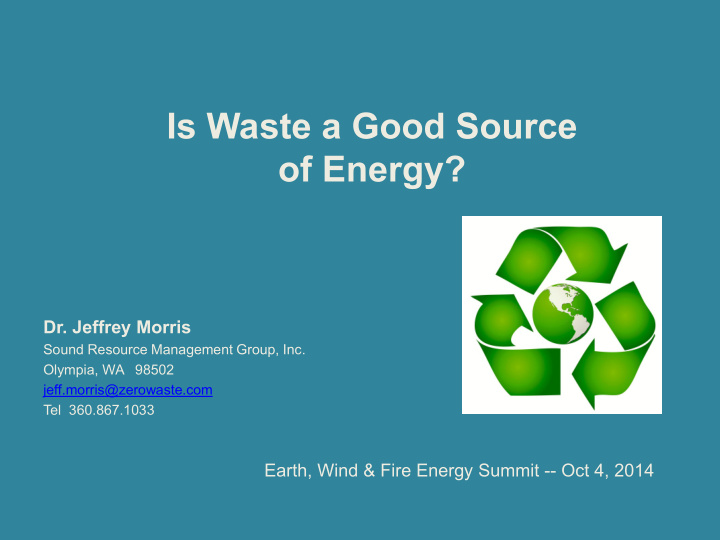



Is Waste a Good Source of Energy? Dr. Jeffrey Morris Sound Resource Management Group, Inc. Olympia, WA 98502 jeff.morris@zerowaste.com Tel 360.867.1033 Earth, Wind & Fire Energy Summit -- Oct 4, 2014
Energy Savings from Recycling vs. Energy Generated from Combustion/Gasification of MSW Materials Million Btus per Ton 250 Virgin-Content Production Recycled-Content Production 200 Recycling Energy Conservation 150 WTE Electricity Generation WTE = Waste-to-Energy MSW = Municipal Solid Waste 100 50 0 Alum Cans PET Bottles HDPE Bottles Newspapers Cardboard Tin Cans Glass Bottles
MSW WTE Facility, Spokane, WA
MSW WTE Pollution Control Equipment
Carbon Footprints for Electricity Generation GHG Emissions (pounds CO2e) per kWh 4.5 4.0 3.5 3.0 2.5 2.0 1.5 1.0 0.5 0.0 Solar Natural Coal MSW WTE Film Wood WTE Gas Plastic WTE Sources: Kim, H. C.; Fthenakis, V.; Choi J-K.; Turney, D. E., 2012. Life Cycle Greenhouse Gas Emissions of Thin-film Photovoltaic Electricity Generation – Systematic Review and Harmonization. Journal of Industrial Ecology 16 (S1): S110-S121; Morris, J., 2010. Bury or burn North American MSW? LCAs provide answers for climate impacts & carbon neutral power potential. Environmental Science & Technology 44 (20): 7944- 7949; Morris, J., 2014. Recycle, Bury, or Burn Wood Waste Biomass? Journal of Industrial Ecology , in peer review; and Whitaker, M. B.; Heath, G. A.; Burkhardt, III, J. J.; Turchi, C. S., 2013. Life Cycle Assessment of a Power Tower Concentrating Solar Plant and the Impacts of Key Design Alternatives. Environmental Science & Technology 47 ( ): 5896-5903.
Motivations for Life Cycle Analysis (LCA) Provide environmental performance assessments for competing products or services Evaluate environmental impacts that are otherwise not counted or are discounted in making choices Provide assessments of multidimensional environmental impacts in monetary units in order to compare against the economic bottom line Connect the dots in complex systems
Schematic of a Product’s Life Cycle Energy Energy Energy Energy Energy Recovery, Raw Product Use Materials Product Recycle, Landfill, Materials or Manufacture Manufacture WTE Conversion Acquisition Consumption Reuse Energy Environmental Environmental Environmental Environmental Environmental Pollution Pollution Pollution Pollution Pollution Product Reuse Material Recycling
WTE vs. Recycling Climate Impacts Paper & Cardboard
WTE vs. Recycling Climate Impacts Film Plastic (LDPE)
Wood Chip Piles, 49 MW Biomass Plant Anderson, CA Source: Dr. Mary Booth, Partnership for Policy Integrity, www.pfpi.net
Life Cycle Environmental Impacts for Clean Wood Waste – Recycle, Bury or Burn 3.0 Number of Std. Dev. Above/(Below) Mean Reconstituted Wood Paper Pulp Fuel (NGas Sub) Fuel (Coal Sub) 0.0 LFGTE (75%) LF Flare (75%) LF Vent (0%) WTE -3.0 Climate Change Acidification Eutrophication Respiratory Non-Cancers Cancers Ecotoxicity Monetized Diseases Overall Score
Monetization Estimates • Climate Change – eCO 2 @ $50 per ton • Acidification – eSO 2 @ $290 per ton • Eutrophication – eN @ $4 per ton • Human Health-Respiratory – ePM 2.5 @ $10,000 per ton • Human Health-Non-Cancers – eToluene @ $30 per ton • Human Health-Cancers – eBenzene @ $3,030 per ton • Ecotoxicity – e2,4-D @ $3,280 per ton
Source Separated Recycling Rates (Seattle 2012) vs. Multi-Family Mixed Waste Processing Recovery Rates Single- Multi- Multi-Family Commercial Self-Haul Total Family Family Dirty MRF Newspaper 96% 83% 79% 18 86% 35 Cardboard 92 80 88 34 86 75 Mixed Paper 87 67 74 5 72 35 Plastics 29 14 15 1 16 50 Glass 92 76 77 20 82 30 Metals 55 22 72 57 62 75 Wood 0 0 0 0 0 ? Yard Debris 99 56 93 79 94 ? Food Waste 62 9 55 0 51 ? Total 71% 32% 61% 11% 55% 25% + ?%
Source Separated Recycling & Composting Trends for Seattle, WA
What Do We Do with Residual Wastes as They Decline – MRBT, LFGTE or WTE? Monetized Overall Environmental Impact (Standard deviations above(+)/below(-) the average impact for all options) 3.00 2.06 2.00 1.00 0.38 0.00 -0.23 -0.50 -1.00 -1.02 -2.00 MRBT HI MRBT LO LFGTE 80% LFGTE 40% WTE Report available at ww.ecocycle.org/specialreports/leftovers
Sources Morris, J., 1996. Recycling versus incineration: An energy conservation analysis, Journal of Hazardous Materials , 47 (1-3 Special Issue on Energy-from-Waste): 277-293. Morris, J., 2005. Comparative LCAs for curbside recycling versus either landfilling or incineration with energy recovery. International Journal of Life Cycle Assessment, 10(4): 273- 284 . Morris, J., 2010. Bury or burn North American MSW? LCAs provide answers for climate impacts & carbon neutral power potential. Environmental Science & Technology 44(20): 7944-7949. Morris, J., Matthews, H.S., Morawski, C., 2013. Review and meta-analysis of 82 studies on end-of-life management methods for source separated organics. Waste Management 33: 545-551. Morris, J., 2014. Recycle, bury or burn clean wood waste. Journal of Industrial Ecology , in peer review .
Thank you. Dr. Jeffrey Morris Sound Resource Management Group, Inc. Olympia, WA 98502 jeff.morris@zerowaste.com Tel 360.867.1033
Recommend
More recommend